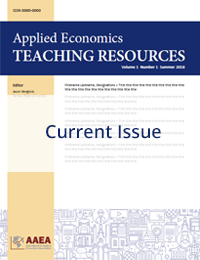Teaching and Educational Methods
Teaching Water Economics by Building Problem-Based Case Studies
David Zetland(a)
(a)Leiden University College
JEL Codes: A12, A22, B52, Q25, Q5
Keywords: Case studies, problem-based learning, teaching, water, x-disciplinary
First Published Online: August 9, 2023
Volume 5, Issue 2
View Full Article (PDF) | Request Teaching Notes/Supplemental Materials
Abstract
Academic economists have many insights to contribute to water management at all scales. These contributions need to be placed in local institutional contexts and reconciled with insights from other disciplines if they are to affect policy, action, and evaluation. Case studies offer a useful way to organize different lines of thinking in the classroom or the field. This article reviews these factors—academic vs. practical perspectives; economic vs. other disciplines—and provides a framework for teaching water economics by building problem-based case studies.
References
Ciriacy-Wantrup, S.V. 1969. “Natural Resources in Economic Growth: The Role of Institutions and Policies.”American Journal of Agricultural Economics 51(5):1314–1324. http://www.jstor.org/stable/1238009.
Coase, R.H. 1998. “The New Institutional Economics.” American Economic Review 88(2):72–74. https://www.jstor.org/stable/116895.
Donoso, G. 2017. “Urban Water Pricing in Chile: Cost Recovery, Affordability, and Water Conservation.” Wiley Interdisciplinary Reviews: Water 4(2):e1194. https://onlinelibrary.wiley.com/doi/abs/10.1002/wat2.1194.
Easter, K.W., M.W. Rosegrant, and A. Dinar. 1999. “Formal and Informal Markets for Water: Institutions, Performance, and Constraints.” World Bank Research Observer 14(1):99–116. https://www.jstor.org/stable/3986540.
Ehrhardt, D., and N. Janson. 2010. “Can Regulation Improve the Performance of Government-Controlled Water Utilities?” Water Policy 12(S1):23–40. https://doi.org/10.2166/wp.2010.112.
Elhadj, E. 2022. “Ozymandias in the Desert: Irrigation in Saudi Arabia. Water International 47(6):969–978. https://doi.org/10.1080/02508060.2022.2123612.
Henrich, J. 2015. The Secret of Our Success. Princeton: Princeton University Press.
Heyerdahl, T. 1950. Kon-Tiki: Across the Pacific in a Raft. London: George Allen & Unwin.
Lansing, J.S. 1991. Priests and Programmers: Technologies of Power in the Engineered Landscape of Bali. Princeton: Princeton University Press.
Levi, M., and B.R. Weingast. 2022. “Analytic Narratives and Case Studies.” In J. Widner, M. Woolcock, and D. Ortega Nieto, eds. The Case for Case Studies: Methods and Applications in International Development. Cambridge: Cambridge University Press, pp. 239–257.
Loaiciga, H.A., and S. Renehan. 1997. “Municipal Water Use and Water Rates Driven by Severe Drought: A Case Study.” Journal of the American Water Resources Association 33(6):1313–1326.
McCloskey, D. 1990. If You’re So Smart: The Narrative of Economic Expertise. Chicago: University of Chicago Press.
North, D.C. 1990. Institutions, Institutional Change and Economic Performance. Cambridge: Cambridge University Press.
OECD. 2019. Education at a Glance 2019. Paris: OECD Publishing. https://www.oecd-ilibrary.org/content/publication/f8d7880d-en.
Ostrom, E. 1965. Public Entrepreneurship: A Case Study in Ground Water Basin Management. Doctoral dissertation, UCLA. https://dlc.dlib.indiana.edu/dlc/handle/10535/3581.
Reimann, N. 2004. “First-Year Teaching-Learning Environments in Economics.” International Review of Economics Education 3(1):9–38. http://www.sciencedirect.com/science/article/pii/S147738801530147X.
Reynaud, A. 2013. “Assessing the Impact of Price and Non-price Policies on Residential Water Demand: A Case Study in Wisconsin.” International Journal of Water Resources Development 29(3):415–433. http://dx.doi.org/10.1080/07900627.2012.721670.
Rubin, A. 2021. Rocking Qualitative Social Science: An Irreverent, but Practical Guide to Rigorous Research. Stanford: Stanford University Press.
Sanders, K.T. 2016. “The Energy Trade-Offs of Adapting to a Water-Scarce Future: Case Study of Los Angeles.” International Journal of Water Resources Development 32(3):362–378. http://dx.doi.org/10.1080/07900627.2015.1095079.
Stein, S.J., G. Isaacs, and T. Andrews. 2004. “Incorporating Authentic Learning Experiences within a University Course.”Studies in Higher Education 29(2):239–258. https://doi.org/10.1080/0307507042000190813.
Vaux Jr., H.J., and R.E. Howitt. 1984. “Managing Water Scarcity: An Evaluation of Interregional Transfers.” Water Resources Research 20(7):785–792.
Venkatachalam, L. 2015. “Informal Water Markets and Willingness to Pay for Water: A Case Study of the Urban Poor in Chennai City, India.” International Journal of Water Resources Development 31(1):134–145.https://doi.org/10.1080/07900627.2014.920680.
Whittington, D. 2016. “Ancient Instincts—Implications for Water Policy in the 21st Century.” Water Economics and Policy 2(2):1671002-1–13. https://www.worldscientific.com/doi/abs/10.1142/S2382624X16710028.
Williamson, O.E. 2000. “The New Institutional Economics: Taking Stock, Looking Ahead.” Journal of Economic Literature 38(3):595–613.
Zetland, D., and B. Colenbrander. 2018. “Water Civilization: The Evolution of the Dutch Drinking Water Sector.” Water Economics and Policy 4(3). https://www.worldscientific.com/doi/abs/10.1142/S2382624X18500121.
Articles in this issue
Contemporary Adjustments Needed to Teaching Water Economics in Light of Changes Facing the Water Sector and Its Users: Introduction to the Special Issue
Ariel Dinar and Mehdi Nemati
Teaching Water Economics Using Dynamics and a Political Economy Framework
David Zilberman, Scott Kaplan, Alice Huang, Lanie Goldberg
Reconciling Theory and Practice in Higher Education Water Economics Courses
Roy Brouwer
Teaching Principles of Water Economics to Non-Economists: Lessons from California
Mehdi Nemati and Ariel Dinar
Innovations for the Water Resource Economics Curriculum: Training the Next Generation
Frank A. Ward
Teaching Water Resource Economics for Policy Analysis
Bonnie Colby
Teaching Water and Sanitation Economics and Policy with a Focus on Low- and Middle-Income Countries
Dale Whittington and Duncan Andrew Thomas
Teaching Water Economics by Building Problem-Based Case Studies
David Zetland
Teaching Water Economics in a Desert Environment
Slim Zekri
Solving Optimal Groundwater Problems with Excel
Christopher A. Wada, Sittidaj Pongkijvorasin, James A. Roumasset, and Kimberly M. Burnett


